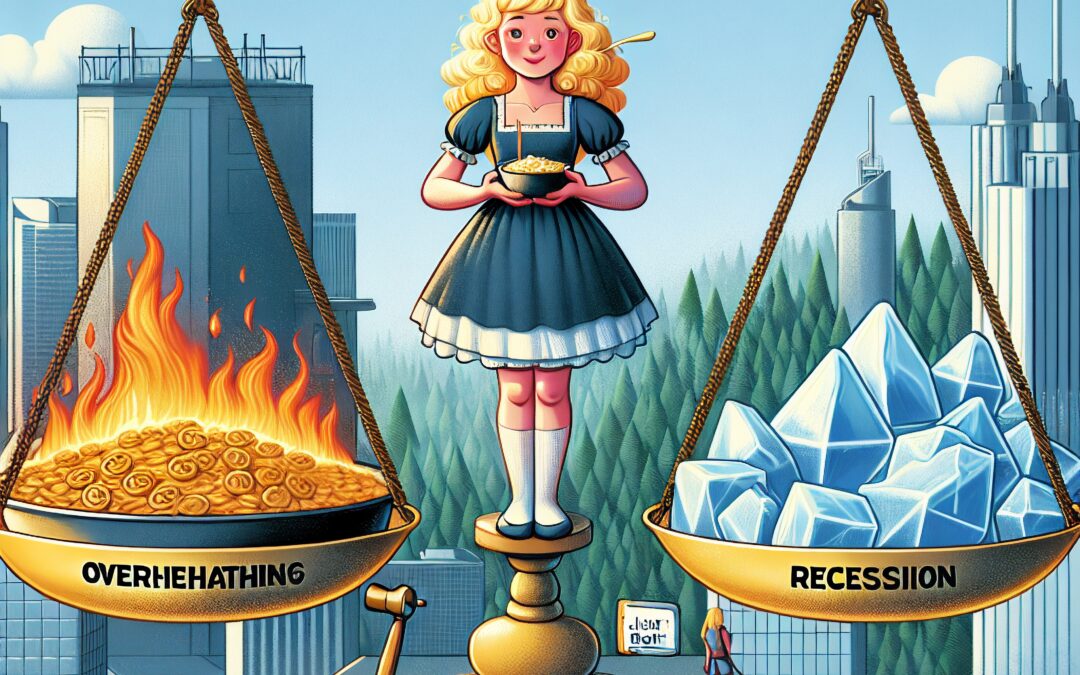Right now, the economy seems like it’s in a “Goldilocks Zone.”
The job market is healthy, inflation is down to just 2.4%, and the Federal Reserve likely won’t see any need to cut rates.
In reality, things aren’t quite so rosy…
Today, I’m going to share some of my latest research indicating that the worst is likely yet to come for the job market, and that inflation isn’t beaten just yet.
Click below to watch today’s video:
Video transcript:
Welcome to Moneyball Economics. I’m Andrew Zatlin, and guess what folks?
This week (and in particular Friday) promise to be a rock and roll day for the markets. That’s when payrolls come out and that’s when we get line of sight as to whether or not the Fed is going to cut rates this month.
Right now, the markets aren’t expecting rate cuts. The markets think the economy’s doing just fine.
Maybe a tiny rate cut in September, another one in December, just a little juice in the tank to keep the economy going strong.
Well, guess what? That’s a huge difference from where the markets were, say two months ago when there was full blown panic that we were going to see a recession. Let’s change. Let’s talk about that.
Let’s talk about what the market thinks is happening and then I’ll talk about where I think the markets are very wrong…
The markets are seeing positive, relatively positive economic data.
That’s why they’re feeling more bullish. For example, when it comes to inflation, we’ve got pretty much a Goldilocks situation. Tariffs were put in place, weak dollar’s out there. All these things should be leading to higher import prices, which in turn leads to inflation. Well, guess what? Inflation’s pretty mellow. 2.4%. In fact, it’s exactly in the range that the Fed wants it to be. It’s a Goldilocks number.
Same thing with labor. Labor is looking pretty darn good out there. Jobless claims moved up a little bit to 240,000 in and of themselves. Still a good number, still reflecting a growing economy and probably going to come down this week. So yet again, a Goldilocks number. Payrolls, well, payrolls this Friday, the consensus is 130,000. That’s a soft number. It’s at the lower end of the range, but if you average out the last three months, we’re looking at 160,000 – 165,000 jobs per month.
Again, Goldilocks.
Now labor and inflation are critical to understanding what the Fed’s going to do because that’s what the Fed focuses on, and if the Fed sees everything in a Goldilocks place, then they’re not going to cut rates and looking out the market’s extrapolating and saying, we see this continuing.
We think the economy’s just fine. So for that reason, we don’t see inflation going up. We don’t see the job market softening that much more. We don’t see any urgency to the Fed cutting rates.
Well, let me share with you why I think the market’s a little bit wrong…
Starting with the fear of recession, I felt that we could have a recession for a basic reason, a practical reason, and that is the collapse in the stock market. When people are buying homes, when they’re buying cars, they basically turned to their 401(k)s. They borrow some money from their assets.
Well, the market was down 15% before April turned around. Not a lot of opportunity to buy cars or buy homes, and so I predicted last month that we would avoid a recession if and only if households went on vacation feeling positive about things, and the only way they would feel positive about things is if Trump pulled a rabbit out of his hat, got the stock market back up and calmed the economic waters.
And guess what? He’s done that He’s done a great job of removing economic anxiety and he’s done a great job of getting the stock market back to where it was. So households are going to go out. They’re going to start buying homes and buying cars. Again, economy studies, we’re not likely going to see a recession the second half for that reason.
However, I do think the expectations of a strong economy are inaccurate.
I think right now we are in an “eye of the hurricane” place, and that means that the storm is just on the horizon. It hasn’t gone away.
Let’s talk about the actual data. So construction, construction is actually down year over year. We’re not seeing expansion and the housing market is one third of our economy. It’s going down because rates are too high. People just aren’t buying homes. The demand is softening. That’s a problem for the economy.
The second problem is manufacturing. Manufacturing data has come in pretty weak. It was up a little bit because again, we had these tariffs in place. Retailers and factories front ran the tariffs. They brought in a lot of inventory and a lot of orders were coming into domestic, not international suppliers. So there was a slight tick up in manufacturing, but guess what? It’s fading. So we’ve got construction, we’ve got the manufacturing bases all softening.
Let’s go back to inflation. Why is inflation in that Goldilocks zone and why could it be problematic going forward?
Well, inflation should be up on imports simply because we’ve got a weak dollar. The cost of importing is going up, and then we’ve got these tariffs. But the reason we don’t have a lot of inflation on imported goods related to the tariff situation is because the tariffs haven’t really taken effect, have they?
Again, retailers, factories, they front ran. They bought months and months of inventory and stockpiled it. So they’re selling at yesterday’s costs, not today’s tariff costs. They can continue to do this until we get to July when those inventories run thin and they’ve got to now go out and buy at the new higher cost levels, or they might not have to.
See, here’s an interesting thing that the Trump administration recently did…
So Trump has been maximalist making these huge demands and then slowly, slowly, slowly reeling them back. Recently he did that with imports, pushing the drop dead deadline to the end of August. That’s a very critical date.
Let me explain why in that US consumer spending really surges during the holidays. That is when we get to August. We’ve got back to school October, we’ve got Halloween, November, we got Black Friday in just those few months, massive amounts of consumer spending, and if you want to sell to consumers, if you want to get that back to school money, that means you got to have the stuff on your shelves in July.
That means it’s got to be on the boats in June. If you really want to hurt the holiday shopping season, you have tariffs in place anywhere up to and through August when all these goods are hitting the US shores and then hitting the shelves, pushing out the deadline for these tariffs to end of August basically means the consumer shopping season has avoided all the inflation that would come at a higher tariff regime.
That was a smart thing to do. It kicks the inflation can at least into next year.
So we might not be seeing as severe inflation. I think the markets have got it wrong. We’re still going to see some, you can’t avoid all of it, but we’re going to avoid most of it. So inflation I think is going to creep up a little bit. Not into the red, not well, maybe into the yellow a little bit.
But again, it’s not going to incent the Fed to cut rates anytime soon.
At the same time, we have a similar eye of the hurricane when it comes to the jobs market, but this is a concerning one to me. When I say eye of the hurricane, what I mean is the jobs market looks pretty solid. Tariffs don’t play a role here.
What plays a role here is all the job cuts that have been going on, whether it’s Doge and the federal government or just in general, all the cutbacks that the federal government has put in place into the private sector.
For example, limiting travel cutting contracts for DEI, cutting billions and billions and billions of dollars out of National Institute of Health spending and on and on and on.
All these things that have cut money going into the private sector and that leads to layoffs. Well, that’s what’s interesting. There’s been over 200,000 people laid off in the year to date 60,000. It workers a hundred thousand doge and federal workers who took early buyouts and on and on and on. 200,000 people minimum have been laid off, but we’re not seeing that in the data and that my friends is where we want to focus.
200,000 people. Either they were fired and they’ve been reabsorbed by the economy, which is hard to believe considering that the payrolls have been going down steadily or something else is going on and that something else is how the government looks at layoffs.
When you get a severance package, what that means is the company has gone to you and told you “we’re going to give you a couple months of salary and in return you sign this form that you won’t sue us.”
The Fed looks at that couple of months of salary, excuse me, the BLS looks at that couple of months of salary and says, “okay, as far as we’re concerned, you’re still on the payrolls and during this time, whether it’s two months, three months, or however long that this severance package covers, you’re also not eligible to file for jobless claims for 60-90 days.”
Let’s talk about again, who’s been laid off. 200,000 people laid off, but they’re almost all white collar professionals. That means they almost all got severance packages. Layoff started in earnest in February. That means if you got a two or three month package by the end of April, you’re now eligible to file for jobless claims and you’re going to start appearing on payrolls is no longer working.
That my friends is what I think we’re about to see.
Jobless claims rocketed up in Massachusetts. They shot up 18,000 in just a couple of weeks. That’s huge. That is massive. That’s about a 30% jump for the state of Massachusetts, and I call out Massachusetts because they’re really at the epicenter of all the concerns we might have when it comes to these layoffs.
Massachusetts scores high when it comes to education, about a hundred thousand faculty and staff are employed in Boston alone at colleges and universities, and we want to talk about other areas that have been hit specifically by the federal government within Massachusetts. Big in it, big in education, big in healthcare, biotech and pharma, big in DEI, all the areas that have been getting hit, left right and center with massive reduction of spending.
Well, Massachusetts is kind of at the forefront and then, guess what?
Massachusetts jobless claims have been soaring. Another data point that kind of confirms that the severance packages are over and we’re going to start to see more jobless claims or lower payrolls. It comes in the form of lower payrolls. It came out with the recent JOLTS data.
JOLTS is job openings, layoffs, and turnovers. It’s an acronym that means this is what the federal government sees in this particular month of intent and if intention when it comes to hiring or firing, translates into action.
The April data is going to speak to May payrolls and the April data, which just came out showed that layoffs, companies firing people surged and it surged in particular in the professional services category. So let me recap. All these layoffs, 200,000 people laid off, haven’t shown up yet, primarily because my theory is the severance package because they’re not counted as no longer working, but those severance packages are now running out.
That means jobless claims will go up, payrolls will go down.
Well, guess what? Jobless claims in Massachusetts suddenly spiked.
I think that’s going to become more widespread. I think the severance packages are going to start showing up.
Secondly, payrolls, lower payrolls. We just saw a massive surge in layoffs in the month of April, which is going to translate into lower payrolls in May. Added together. This is the beginning of a wave of bad labor data, and that’s why I disagree with the markets.
I don’t think we’re in a Goldilocks place. I think inflation is going to be problematic going forward. I think the broader economy is going to be problematic going forward, and I think that the labor data is going to be problematic going forward, and I think the Fed isn’t sure what to do because if they cut rates in a high inflation regime, that’s tricky.
Is it stagflation?
I don’t want to call it that, but I do know that the markets have got it a little bit too bullish and they’re going to have to recalibrate and that’s going to be bad news for the stock and bond markets.
Let’s look out for 130,000 on Friday. I actually think it’s going to be 130,000. I am in agreement with the markets, excuse me, I’m at 129,000, 126,000 technically, so I’m at 126,000 with payrolls this Friday. Pretty much in line with the markets.
I get there a little bit differently. I think payrolls are pretty strong. I just think we’re all of a sudden going to start documenting all these backward looking layoffs that happened earlier in the year. In any case, the key concern here is on Friday everything’s going to look great, but then going forward, things are going to start to break apart a little bit and the markets are going to get caught out and have to recalibrate, and that’s bad news.
And you want to protect your investments, expect volatility played accordingly. You might buy gold just to be on the safe side. Not this month, but next month when the July payrolls are due to hit. I’m in it to win it. So are you. Let’s stick together, fellow Moneyball economists.
Zatlin out.

Andrew Zatlin
Editor, Moneyball Economics
For a deeper dive into his latest predictions and track record, check out Andrew Zatlin reviews of the Superforecast Trader research service.





